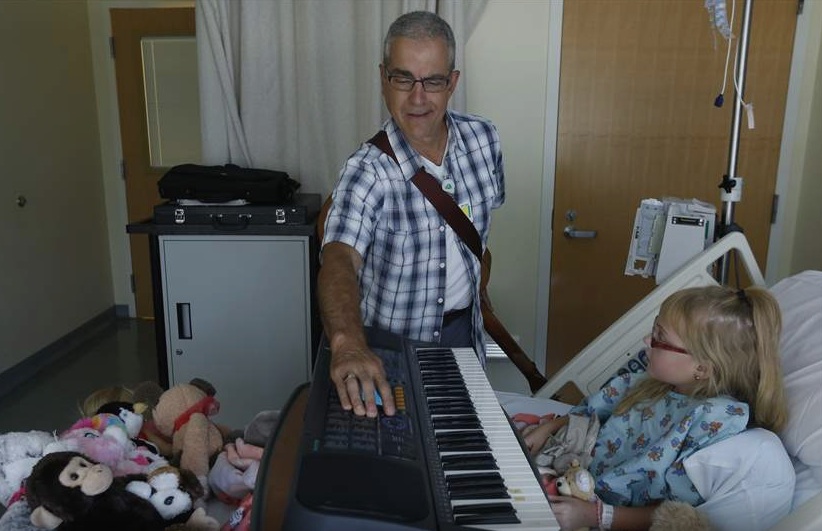By ROBERTA GEDERT | THE BLADE
Nine-year-old Hannah Gorham loves to sing.
She loves Carrie Underwood and reading Fancy Nancy books, and she adores Bear-y, the tattered stuffed animal blanket she has had since birth.
Her hero is Calysta Bevier, the 16-year-old ovarian cancer survivor from Hannah’s hometown of Grand Rapids, Ohio, who advanced to the semi-finals on the popular NBC show America’s Got Talent.
And Hannah’s therapeutic savior might just be music.
In ProMedica Toledo Children’s Hospital since Aug. 31 for severe migraines, Hannah was introduced recently to music therapy, a growing practice for hospitalized children and those with developmental or physical disabilities.
Operated through the hospital’s Child Life program, music therapy helps children and their families cope with stresses related to a child’s illness and the adjustment of a hospital stay. David Putano, a music therapist who owns a private practice in Toledo, visits children like Hannah at the hospital for weekly one-on-one musical sessions.
“When you expose people to music they love, the feeling of success, of hopefulness, reminds them of things they love,” Mr. Putano said. “At a hospital, we sometimes get away from things at home that we love, things that are beautiful.”
On this particular Friday, surrounded by stuffed tigers, monkeys, and dolls, Hannah, a quiet, petite blonde with glasses, finds her place on the keyboard and joins Mr. Putano in making music. The pair first coordinate musical notes to a preprogrammed rhythm (this, time, they choose one reminiscent of an epic space movie; Mr. Putano often uses movie references to get students in the right creative frame of mind). As Mr. Putano plays the guitar, Hannah finds her happy place on the keyboard and joins in.
“OK, start going slower, we are going to sneak up on the ending,” Mr. Putano prompts. “When I count to three, you play one more note.”
Twice, the session is interrupted so that Hannah can take medication. Then, it’s back to the beat.
Hannah watches intently as Mr. Putano searches for the perfect hip-hop beat on the keyboard. She clutches Bear-y as he explains to the young girl that there are 12 notes in music and helps her find the A note on the keyboard.
“Play whatever you want … Atta girl!” he encourages.
“You can tell when someone is really wired for music. You do really well,” he says to his tiny student as they finish up.
She smiles. Quietly.
“My favorite part was doing this with David. It made me happy,” Hannah said after the lesson. “It feels good.”
Soothing the soul
Hannah was diagnosed two years ago with Chiari malformation, a congenital defect in which part of the skull at the back of the head is too small for the brain.
“She started stuttering; she would trip over things and there would be nothing there,” said her grandfather, Rick Tolles, also of Grand Rapids.
Her mother, Heather Gorham, was optimistic that music therapy would help.
“Heck, it’s worth a shot. All of this medication is hard on her little body, but if something like this would work, that would be fantastic,” she said.
The young girl had been getting migraines for about a year, but a week into fourth grade, they became severe, Mr. Tolles said. Now, when she gets a migraine, Hannah runs to her grandfather and hides in the crook of his arm to shield herself from the light.
“I think the biggest thing is the music. It makes her rest easier — I can get her to close her eyes,” he said. “I haven’t found much else that helps.”
Music is considered to be a primary cognitive experience, meaning as human beings, we have no control over the emotions we feel when we experience it, Mr. Putano said.
“If we can identify music that a patient loves, music they have positive associations with … if we can engage them in playing music that they really like a lot, we can instantly have them experience those positive emotions,” he said.
Music versus medicine
Researchers have found that music therapy provides a diversion from negative feelings and helps manage the pain of not only adults but of children with developmental, physical, behavioral, and neurological disabilities, said Al Bumanis, a certified music therapist and now the spokesman for the American Music Therapy Association. Continued research with music shows effects on the subjects’ vital signs: blood pressure goes down, the heart rate slows, body temperature goes up; it calms and relaxes but also motivates.

